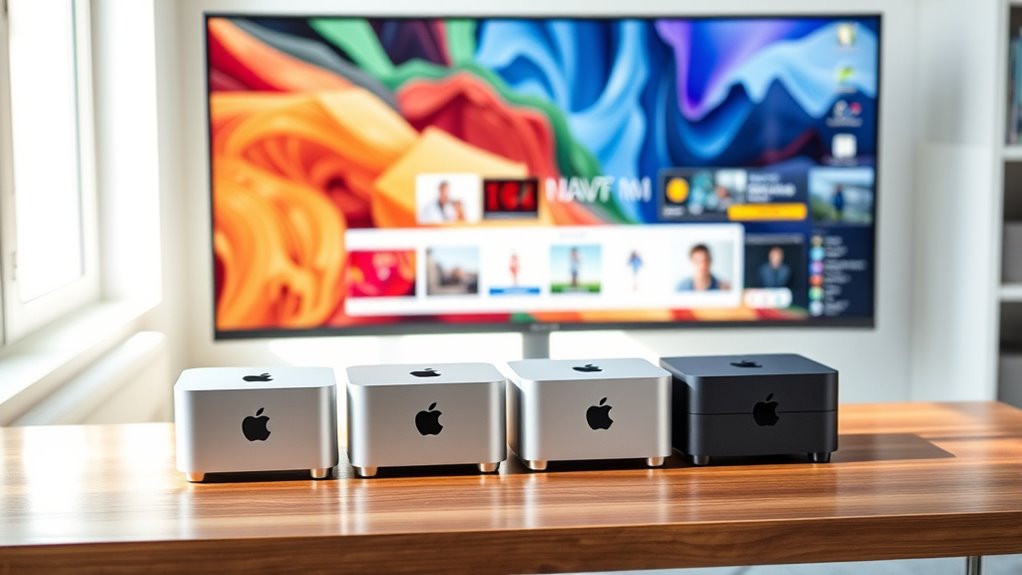If you’re looking for the best Mac Mini models to serve as a media server in 2025, I recommend considering the latest versions with the M4 or M4 Pro chips for top performance. Opt for models with at least 16GB of RAM and 256GB SSD or larger for smooth multitasking and media storage. Multiple ports like Thunderbolt and HDMI guarantee easy expansion. Keep in mind future-proof features—continue exploring to find the perfect fit for your media needs.
Key Takeaways
- Opt for models with the M4 Pro chip for superior multitasking and high-performance media processing.
- Prioritize configurations with at least 512GB SSD and 16GB RAM for extensive media libraries and smooth streaming.
- Ensure multiple Thunderbolt, USB-C, and HDMI ports for versatile device and peripheral connectivity.
- Choose models with robust security features, including hardware encryption and regular macOS security updates.
- Select versions compatible with the latest macOS and Apple ecosystem features for seamless media sharing and integration.
Apple Mac mini Desktop Computer with M4 Chip (256GB SSD, 16GB RAM)
If you’re looking for a compact yet powerful media server, the Apple Mac mini with the M4 chip is an excellent choice, especially for those who need reliable performance in a small form factor. Its five-by-five-inch design fits easily next to monitors or in tight spaces, yet it packs a punch with a 10-core CPU and GPU. With 16GB of unified memory and a 256GB SSD, it handles streaming, editing, and multitasking smoothly. The range of ports—Thunderbolt, HDMI, USB-C—ensures versatile connectivity. Running macOS optimized for Apple Silicon, it integrates seamlessly with your devices while maintaining strong privacy and security features.
Best For: users seeking a compact, powerful media server capable of handling streaming, editing, and multitasking with seamless connectivity and robust performance.
Pros:
- Compact size fits easily in small spaces and next to monitors
- Powerful M4 chip with 10-core CPU and GPU ensures fast, fluid performance
- Versatile connectivity options including Thunderbolt, HDMI, and USB-C
Cons:
- Limited internal storage at 256GB may require external drives for large media libraries
- No dedicated graphics card, which could impact high-end gaming or intensive graphic tasks
- macOS ecosystem may limit compatibility with some Windows-specific applications
Apple Mac mini Desktop Computer with M4 Chip (2024)
The Apple Mac mini Desktop Computer with M4 Chip (2024) stands out as an ideal choice for those seeking a compact yet powerful media server, thanks to its impressive performance powered by the M4 chip’s 10-core CPU and GPU. Its small 5×5-inch design makes it easy to place next to your monitor or anywhere in your setup. With 16GB of unified memory and a 512GB SSD, it handles multiple streams and large media libraries effortlessly. The extensive connectivity options, including Thunderbolt, HDMI, and USB-C ports, ensure seamless integration with various devices. It’s a perfect blend of efficiency, power, and space-saving design for a media server in 2025.
Best For: individuals seeking a compact, high-performance media server that seamlessly integrates with their Apple ecosystem and offers efficient space-saving design.
Pros:
- Compact size (5×5 inches) perfect for small spaces and easy placement.
- Powerful M4 chip with 10-core CPU and GPU delivers fast, smooth performance.
- Extensive connectivity options including Thunderbolt, HDMI, and USB-C for versatile device integration.
Cons:
- Limited 512GB SSD storage may require external drives for large media libraries.
- Premium price point might be a consideration for budget-conscious buyers.
- Limited upgradeability due to integrated hardware design.
Apple 2024 Mac mini Desktop with M4 Chip
The Apple 2024 Mac mini Desktop with M4 Chip stands out as the top choice for those seeking a compact yet powerful media server in 2025. Its small five-by-five-inch design fits easily beside monitors or in tight spaces, yet it packs impressive performance thanks to the M4 chip with a 10-core CPU and GPU. With 24GB of unified memory and a 512GB SSD, it handles multitasking and data access effortlessly. Connectivity options like Thunderbolt, HDMI, and USB-C make expansion simple. Built-in Apple software, privacy features, and seamless integration with other Apple devices make this Mac mini an ideal, efficient media server for any setup.
Best For: individuals or small teams seeking a compact, powerful, and energy-efficient media server that seamlessly integrates with the Apple ecosystem.
Pros:
- Compact size easily fits in tight spaces or beside monitors for a clean setup
- Powered by the advanced M4 chip with high-performance CPU and GPU cores for smooth multitasking
- Robust connectivity options including Thunderbolt, HDMI, and USB-C for flexible expansion
Cons:
- Limited internal storage with 512GB SSD may require external drives for large media libraries
- Slightly higher price point compared to other small-form-factor servers with similar specs
- No dedicated graphics card slot, which could limit certain high-end media processing tasks
Apple 2024 Mac mini with M4 Pro chip and 24GB RAM
For those seeking a powerful yet compact media server in 2025, the Apple 2024 Mac mini with M4 Pro chip and 24GB RAM stands out. Its small five-by-five-inch design fits effortlessly beside monitors or in tight spaces, while packing serious performance. Powered by the 12-core CPU and 16-core GPU of the M4 Pro, it handles demanding tasks like streaming high-resolution content or managing large media libraries. With 24GB of unified memory and a 512GB SSD, it offers speed and storage. Multiple ports, including Thunderbolt, HDMI, and Ethernet, ensure seamless connectivity. Plus, its integration with the Apple ecosystem makes it a versatile, secure, and eco-friendly choice.
Best For: users seeking a compact, high-performance media server that seamlessly integrates with the Apple ecosystem and handles demanding multimedia tasks.
Pros:
- Compact design fits easily into tight spaces and next to monitors
- Powerful M4 Pro chip with 12-core CPU and 16-core GPU ensures fast multimedia processing
- Excellent ecosystem integration with features like iPhone Mirroring, Messages, and FaceTime
Cons:
- Limited upgrade options for storage and memory after purchase
- Premium price point may be high for budget-conscious users
- Less suited for heavy gaming or specialized professional applications outside media management
Factors to Consider When Choosing Mac Mini as a Media Server

When selecting a Mac Mini for your media server, I consider key factors like processing power, storage options, and connectivity to guarantee smooth performance. It’s also important to think about how well it integrates with my ecosystem and the level of privacy and security it offers. These points help me choose a model that fits my media needs perfectly.
Processing Power Needs
Since smooth streaming and multitasking depend heavily on processing power, selecting a Mac Mini with a robust CPU is essential for a media server. A multi-core processor, like a 10-core or higher, ensures efficient handling of demanding tasks such as transcoding and real-time encoding. Faster processors reduce buffering and greatly improve playback quality, especially for high-resolution content. Increased processing capabilities also enable the Mac Mini to manage multiple streams simultaneously without lag or performance issues. Choosing a model equipped with a powerful chip, like the M4 Pro or M4, provides future-proofing as media demands grow. Ultimately, investing in a high-performance CPU ensures your media server runs smoothly, delivering seamless streaming and a reliable user experience in 2025.
Storage Capacity Options
Choosing the right storage capacity is vital for guaranteeing your Mac Mini can handle your media library effectively. Storage options typically range from 256GB to 2TB SSDs, giving you flexibility based on your media collection size. If you have extensive high-resolution videos or large music libraries, larger capacities are advantageous, allowing you to host everything without external drives. It’s also wise to reflect on future growth; higher capacity drives can accommodate expanding media files without needing upgrades soon. External storage solutions can supplement internal SSDs, offering additional flexibility if your needs change. Keep in mind that SSDs provide faster data access and transfer speeds, which are critical for smooth media streaming and quick file access. Selecting the right storage capacity ensures peak performance and future-proofing your media server setup.
Connectivity Features
Selecting the right connectivity features is essential for transforming your Mac Mini into an effective media server. I look for models with multiple Thunderbolt and USB-C ports to connect external storage, displays, and audio equipment seamlessly. A Gigabit Ethernet port is critical for high-speed wired connections, ensuring reliable streaming of large media files without buffering. HDMI output is a must-have for direct connection to monitors or TVs, simplifying media management and playback. I also consider the number and accessibility of front-facing ports to easily connect peripherals like external drives, webcams, or microphones. Finally, fast data transfer rates are essential, allowing multiple media streams to run simultaneously without lag, making your media server setup smooth and efficient.
Ecosystem Compatibility
To guarantee your Mac Mini works seamlessly as a media server, it’s crucial to verify its compatibility with your existing Apple devices. Make sure the macOS version supports your preferred media apps and streaming services, so everything runs smoothly. Check that your iPhone, iPad, and Apple TV can easily connect, sync, and share content via features like AirPlay, iCloud, and Continuity. These integrations simplify media management and improve your experience. Additionally, ensure the Mac Mini supports the latest Apple ecosystem features, such as iPhone Mirroring and cross-device messaging, to expand your media options. Hardware capabilities also matter; a powerful processor and ample memory help with smooth playback and effortless integration across your devices. Compatibility is key to creating a unified, hassle-free media setup.
Privacy and Security
When setting up your Mac Mini as a media server, prioritizing privacy and security is essential to protect your personal data and media content. Guarantee the device has robust privacy features like hardware encryption and secure boot capabilities to prevent unauthorized access. Verify that it supports the latest macOS security updates, which patch vulnerabilities and strengthen defenses. Use strong, unique passwords and enable two-factor authentication for remote access, adding an extra layer of security. Regularly update the system software and security patches to stay protected against emerging threats. Implement network security measures such as firewalls and VPNs to safeguard data transmitted to and from your server. These steps collectively help maintain your media server’s integrity, keeping your content safe from potential breaches.
Frequently Asked Questions
How Does the M4 Chip Improve Media Server Performance?
The M4 chip boosts media server performance by offering faster processing speeds and improved energy efficiency. I notice quicker data handling and smoother streaming thanks to its advanced architecture. The chip’s enhanced graphics and neural engine also allow for seamless transcoding and multi-tasking, making my media server more reliable and efficient. Overall, it’s a significant upgrade that helps me stream, transcode, and manage media effortlessly.
What Are the Best Storage Options for Mac Mini Media Servers?
I recommend using SSDs for your Mac Mini media server because they offer fast read/write speeds, which are vital for streaming high-quality media smoothly. Internal SSDs provide quick access and reliability, but if you need more space, consider using external drives via Thunderbolt or USB-C with RAID configurations for redundancy. Cloud storage can also supplement local options, ensuring your media library stays accessible and secure.
Can the Mac Mini Handle 4K or 8K Media Streaming?
Absolutely, the Mac Mini can handle 4K and even 8K media streaming, especially with the M1 or M2 chips. I know some might worry about performance, but these models are powerful enough to stream high-resolution content smoothly. Just make certain you have a fast enough internet connection and a compatible display. With the right setup, you’ll enjoy seamless 4K and 8K playback without any hiccups.
What Are the Cooling Solutions for Prolonged Media Server Use?
For prolonged media server use, I rely on the Mac Mini’s built-in cooling system, which efficiently manages heat during extended operation. If I want extra assurance, I use a cooling pad or elevate the device for better airflow. Keeping my environment cool and ensuring good ventilation helps prevent overheating. Regularly cleaning vents and avoiding clutter around the Mac Mini also keeps it running smoothly during long media streaming sessions.
How Does Network Connectivity Impact Media Server Efficiency?
Imagine streaming your favorite movie, but buffering ruins the moment—that’s what poor network connectivity can cause. It directly impacts media server efficiency by slowing data transfer, leading to lag or interruptions. For example, I once upgraded to a Gigabit Ethernet connection, and suddenly, my streaming was seamless, even with multiple devices. Reliable, fast network connections are essential for smooth media serving, especially when handling large files or multiple streams simultaneously.
Conclusion
Choosing the right Mac mini feels like a perfect coincidence—it’s about matching your needs with a device that surprises you with its power and versatility. Whether you go for the M4 or M4 Pro, each model offers something unique, making it easier to turn your media setup into a seamless experience. Sometimes, the best choice just feels right, aligning with your goals in the quietest yet most meaningful way.










